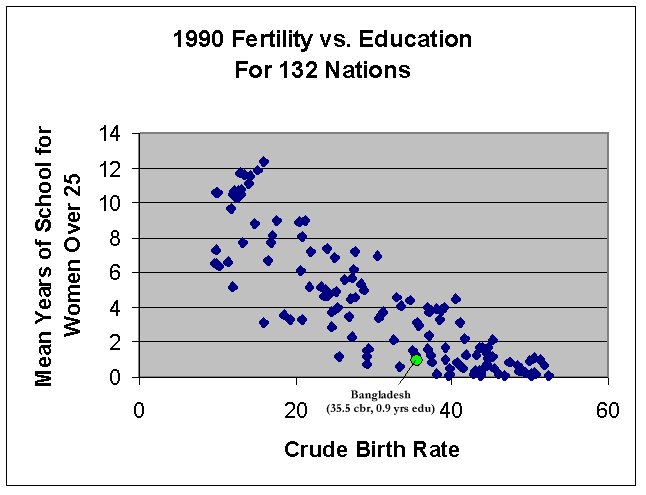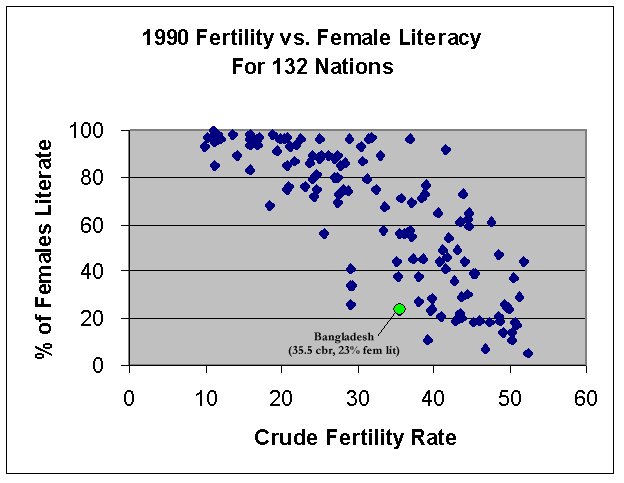
Conclusions
Yunus describes his attitude towards population growth as follows: "Population is not the problem. If you had a lot of land, would you worry? No, you wouldn't. You'd think it was a source of income. If you had a lot of trees, you wouldn't worry. So why worry if there are a lot of people? Because they eat. They take away resources. But you're only looking at one side of the picture; you forget that they also produce. You're not seeing that part of it and that's why you worry. I see the other part. I see that people are creative. You worry because you don't promote that creativity. You don't allow them to produce things. If we provide opportunities for people, we don't have to worry about them." (Bornstein, 1996) This view of people as creative resources is what allowed Yunus to develop the idea of microcredit, in which the rural poor create their own economic opportunities. The Grameen Bank has used the tool of microcredit to successfully address the problems of poverty among rural landless women. Its model has proved to be robust enough to not only survive the onslaught of natural disasters, but blunt their impact on Grameen members.
The exhibit above shows the conceptual model Grameen follows today. It uses a broad set of "action tools" such as business development and health programs centered around microcredit in order to impact the factors that contribute to poverty. These factors, or "leverage points" for poverty include creating economic opportunity, raising the status of women, and others. Grameen sees alleviating poverty as its single goal. Note that action tools impact multiple leverage points. For example, housing loans increase adequate housing, economic opportunity, and the status of women (the houses are in the woman's name). Note also that many connections exist between leverage points where one impacts the other. For example, lowering the impact of floods directly or indirectly improves all of the other leverage points.
Exhibit 51 - Expanded Grameen Model

The Grameen Bank should take the issue of population growth more seriously, however. The exhibit above shows an expanded and more complete conceptual model that Grameen should adopt, with new elements shown in purple. This model adds population growth as a root problem to be addressed in addition to poverty. This expanded model also shows a two-way relationship between the leverage points and the root problems. For example, many of the leverage points such as literacy and use of contraception influence population growth. Population growth in turn influences leverage points such as landholding, low impact of natural disasters, and adequate food (and other possible leverage points not explored in this paper, such as deforestation and pollution). By influencing the leverage points, the two root problems influence each other, as represented by the dotted double arrow joining them in the model. Therefore, in order for Grameen to achieve its mission of eradicating poverty, it must work to stabilize population in Bangladesh.
Grameen already contributes to stabilizing population by (1) reducing fertility by raising the status of women and (2) reducing the impact of natural disasters that would create conditions for population growth. Grameen can do even more by incorporating two additional action tools into their strategies: family planning and education for women. Doing so would fit Grameen's current strategy of expanding its services beyond loans. Grameen could develop ways to integrate family planning and educational services into its own operations, but it may not want to lose focus from its current strategies. At the very least, Grameen should promote, coordinate efforts with, and lend assistance to other government and NGO programs that specialize in family planning and education.
Grameen can have an especially large impact through these action tools because its target group (rural poor) experience higher fertility rates than other sectors of society. Grameen members are 94% women, making it an ideal vehicle to communicate and promote female education and the use of contraception by women.
Exhibit 52 - Fertility vs. Female Education
Exhibit 53 -Fertility vs. Female Literacy


Grameen might be able to have a larger impact by focusing on educating women than through family planning. Family planning programs have been fairly successful in Bangladesh and had grown the use of contraception from 3% to 45% of all women by 1990. These programs have been the main force driving the decline in fertility since the 1970s. Education and literacy for women had not progressed as far in 1990, with only 23% of women able to read and an average schooling of less than one year for women over 25 (compared to 47% literacy and over three years of schooling for men). The above exhibits show Grameen's position relative to other nations in terms of comparing fertility rates with literacy and education rates. In both cases, Bangladesh has one of the lower fertility rates among countries with similar education and literacy rates. This accomplishment is due to Bangladesh's successful family planning programs (which have moved Bangladesh's data point to the left on the exhibits). The exhibits suggest that the benefits of family planning have largely been achieved for Bangladesh and that Bangladesh can continue to reduce fertility by raising education and literacy rates (which corresponds to moving Bangladesh's data point up and to the left in the exhibits, following the path laid by other nations). This importance of education and literacy for Bangladesh agrees with the evidence from the linear regression performed on regional literacy and fertility data.
Cultural and economic factors vary widely between regions in Bangladesh, so Grameen should attempt to understand the primary factors that contribute to fertility in each region and act accordingly. Grameen should also target zones that have the highest rates of fertility and the highest population density because these two factors together determine the amount of population growth over time. The regional data used in this report is of limited use due to its timeliness (1991 data), its accuracy (using the percent of population under four as a proxy for fertility rates), and its completeness (data was limited to the factors of % urban, % females literate, % females economically active, and % Muslim). With its large network, Grameen should do some data collection of its own to better understand which factors most influence fertility regionally. It should also track this data over time to understand how fertility and these factors are changing. Despite its current limitations, the current data does suggest some possible actions that Grameen should evaluate. All of these suggestions focus on reducing fertility and ignore other goals and factors which Grameen should take into account. The easiest way to understand these suggestions is to refer to the Bangladesh Zonal Maps.